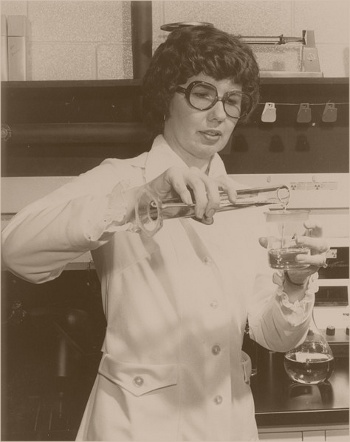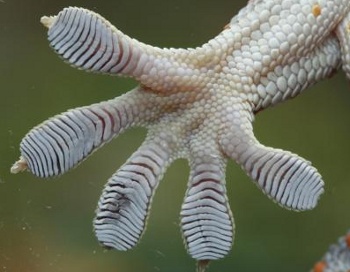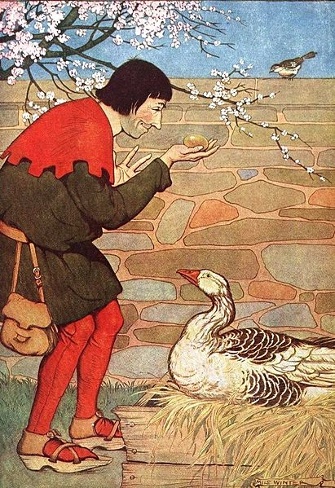Oddball Science
March 19, 2014
At a
conference at
Columbia University in 1958,
Nobel Prize winning
physicist,
Niels Bohr (1885-1962), told another Nobel laureate,
Wolfgang Pauli (1900-1958), "We are all agreed that your
theory is crazy. The question that divides us is whether it is crazy enough to have a chance of being correct." This
quotation was documented by
mathematical physicist,
Freeman Dyson.[1]
Novel
scientific ideas are initially perceived as crazy, since everyone's mindset is on "
normal science," and the best new ideas are always
paradigm changing. The popular conception of a brilliant
scientist is a
white-coated oddball doing oddball things.
James Watson, as one example, has proudly cultivated the
boffin image.

Lab coats of my generation.
1978 photo of NASA scientist, Barbara S. Askins.
Askins invented a method of restoring photographic and X-ray negatives.[2]
(NASA image via Wikimedia Commons.)
The
etymology of the word, "oddball," is not established. Since the word seemed to appear just after
World War II, there's a suggestion that it was
aviator slang for something amiss. In the days before
electronic instrumentation, aircraft were equipped with a crude
inclinometer consisting of a ball in a curved
glass tube filled with a
damping liquid. The ball would remain centered during level flight; and, if it wasn't centered, an "odd ball," there might be a problem.
My own etymological
theory is that the concept goes back
millennia to the time when
votes were cast by putting white or black balls in a vessel. A tie-breaker would be the "odd ball," since only an
odd number of votes will ensure a definitive outcome. That's one reason why the
Supreme Court of the United States, known in the Internet age as
SCOTUS, has nine members.
Some non-scientists ridicule oddball scientific studies, perhaps because they don't understand the necessity of oddball science. In particular,
US Senator,
William Proxmire, launched attacks on oddball science in 1975 when he initiated his
Golden Fleece Award to highlight what he considered to be wasteful
government spending.
The
National Science Foundation received some Golden Fleece Awards, as did
NASA for its support of
SETI (the Search for extraterrestrial intelligence). There has been no US government funding of SETI since the mid-1990s, probably as a consequence of the Golden Fleece Award. To the
common man, it makes much more sense to fund better
cellphone video than
eavesdropping on
little green men, or
larger grey men.
As the saying goes, "
The proof of the pudding is in the eating," and oddball science has generated quite a few useful results.
Patricia L. R. Brennan,
Duncan J. Irschick,
Norman Johnson and
R. Craig Albertson of the
University of Massachusetts Amherst have just published an article in
BioScience entitled, "Oddball Science: Why Studies of Unusual Evolutionary Phenomena Are Crucial."[3] The article argues the principle that "innovations often arise from unlikely sources."[3-4]
Since the authors are
biologists, the article's emphasis is on
biological research. First author of the article, Patricia L. R. Brennan, does research on
duck genitalia.[5] This research has been criticized as a waste of government money, as have other oddball studies on
snail sex,
shrimp running on a
treadmill, and
robotic squirrels.[3-4] There's a mindset that the only research projects that should be funded are those with a foreseeable benefit.[3] However, as all scientists know, innovation does not proceed in a linear fashion from planned research.[3]
One example that the authors cite, from their own
university, is research on the ability of the
gecko to walk up walls and across ceilings. This ability arises from the structure of the
lizard's toe pads, which are covered with soft
hairs that conform to surfaces to enable strong
adhesion.[3] This fundamental research on the gecko has allowed development of Geckskin, a reusable,
glue-free adhesive pad capable of holding heavy weights on smooth surfaces.[4]

Gecko toepads.
The gecko is an advertising icon of the insurance company, GEICO. Lizards hanging upside-down from ceilings should have insurance.
(University of Massachusetts Amherst image.)
The Amherst authors state that there are more than 2,000
technology innovations inspired by
basic research in biology, such as highly
efficient solar panels,
body armor inspired by
mantis shrimp exoskeleton, and a
diabetes drug based on studies of
Gila monster venom.[3-4] There is also the example of the
enzyme,
Taq polymerase, discovered in
thermophilic bacteria in
Yellowstone National Park, and the basis for the
polymerase chain reaction (PCR).[4]
As a counterpoise to the Golden Fleece Award, the
Golden Goose Award

(Image by Milo Winter from Aesop for Children, Project Gutenberg etext 19994, via Wikimedia Commons.)
Even experienced physicists did not believe that a maser was possible, but Townes persisted. The Amherst authors write,
"Scientific innovations arise from a mix of curiosity, creativity, and knowledge, and the connection between basic and applied science is a network of knowledge that builds over time to generate life-changing ideas."[3]
References:
- Gregory Foster, "Freeman Dyson on innovation in physics," February 21, 2010.
- Barbara S. Askins, "Method of obtaining intensified image from developed photographic films and plates," US Patent No. 4,101,780, July 18, 1978.
- Patricia L. R. Brennan, Duncan J. Irschick, Norman Johnson and R. Craig Albertson, "Oddball Science: Why Studies of Unusual Evolutionary Phenomena Are Crucial," Bioscience, Advance Article (February 6, 2014), DOI: 10.1093/biosci/bit039.
- Janet Lathrop, "'Oddball Science' Has Proven Worth, Say UMass Amherst Biologists," University of Massachusetts Amherst Press Release, February 27, 2014.
-
Patricia Brennan, "Why I study duck genitalia, Slate, April 2, 2013.
-
Emily Underwood, "First Golden Goose Awards honor ideas that hatched unexpectedly," Science Insider, September 10, 2012.
Permanent Link to this article
Linked Keywords: Academic conference; Columbia University; Nobel Prize in Physics; physicist; Niels Bohr (1885-1962); Wolfgang Pauli (1900-1958); theory; quotation; mathematical physics; mathematical physicist; Freeman Dyson; science; scientific; normal science; paradigm change; scientist; white coat; oddball; James Watson; boffin; baby boomer; my generation; NASA; photographic film; X-ray; negative; Wikimedia Commons; etymology; World War II; pilot; aviator; slang; electronic; instrumentation; inclinometer; glass; damping; liquid; theory; millennia; voting; vote; parity; odd; Supreme Court of the United States; United States Senate; US Senator; William Proxmire; Golden Fleece Award; government spending; National Science Foundation; NASA; Search for extraterrestrial intelligence; SETI; common man; cellphone; video; eavesdropping; little green men; grey alien; larger grey men; Miguel de Cervantes; Don Quixote; The proof of the pudding is in the eating; Patricia L. R. Brennan; Duncan J. Irschick; Norman Johnson; R. Craig Albertson; University of Massachusetts Amherst; BioScience; biologist; biology; biological; research; duck; sex organ; genitalia; snail; animal sexual behaviour; sex; shrimp; treadmill; Robosquirrel; robotic squirrel; university; gecko; lizard; toe pad; hair; adhesion; glue; advertising icon; insurance company; GEICO; technology; fundamental science; basic research; energy conversion efficiency; efficient; solar panel; body armor; mantis shrimp; exoskeleton; diabetes mellitus; exenatide; drug; Gila monster; venom; enzyme; Taq polymerase; thermophilic bacteria; Yellowstone National Park; polymerase chain reaction; Golden Goose Award; American Association for the Advancement of Science; scientist; invention; quality of life; Charles Townes; maser; laser; Aesop; Project Gutenberg; curiosity; creativity; knowledge; Barbara S. Askins, "Method of obtaining intensified image from developed photographic films and plates," US Patent No. 4,101,780, July 18, 1978.